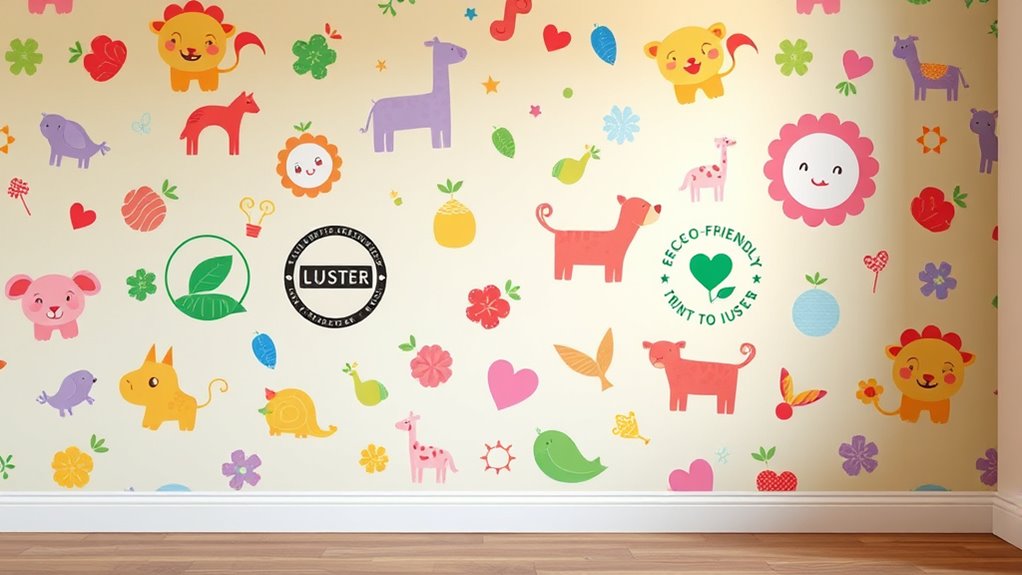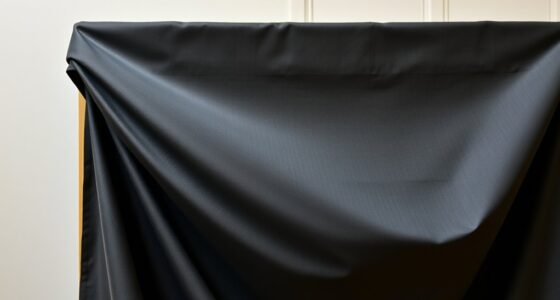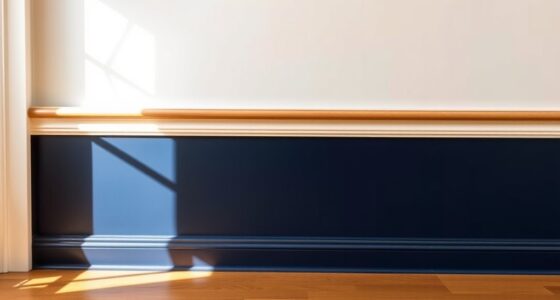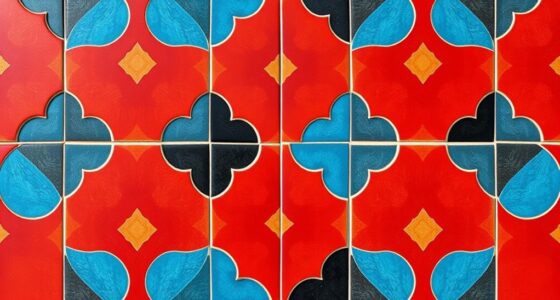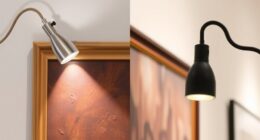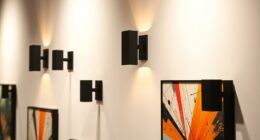When choosing child-safe wallcoverings, look for certifications like GREENGUARD Gold or OEKO-TEX Standard 100, which verify low chemical emissions and environmental safety. These labels guarantee products meet strict standards for indoor air quality and durability, helping protect your children’s health. Verify manufacturer transparency by reviewing testing reports and certifications to confirm authenticity. If you want to learn more about ensuring wallcovering safety, there’s important information ahead that can guide your decision.
Key Takeaways
- Look for certifications like GREENGUARD Gold or Blue Angel that verify low chemical emissions in wallcoverings.
- Check for safety labels indicating non-toxic, low-emission, or chemical-free products suitable for children.
- Confirm wallcoverings meet recognized safety standards through third-party testing and official certifications.
- Choose products with environmental certifications such as OEKO-TEX Standard 100 to ensure eco-friendly materials.
- Verify manufacturer transparency by reviewing detailed safety data and certification authenticity before purchase.
Understanding VOC Emissions and Indoor Air Quality Standards
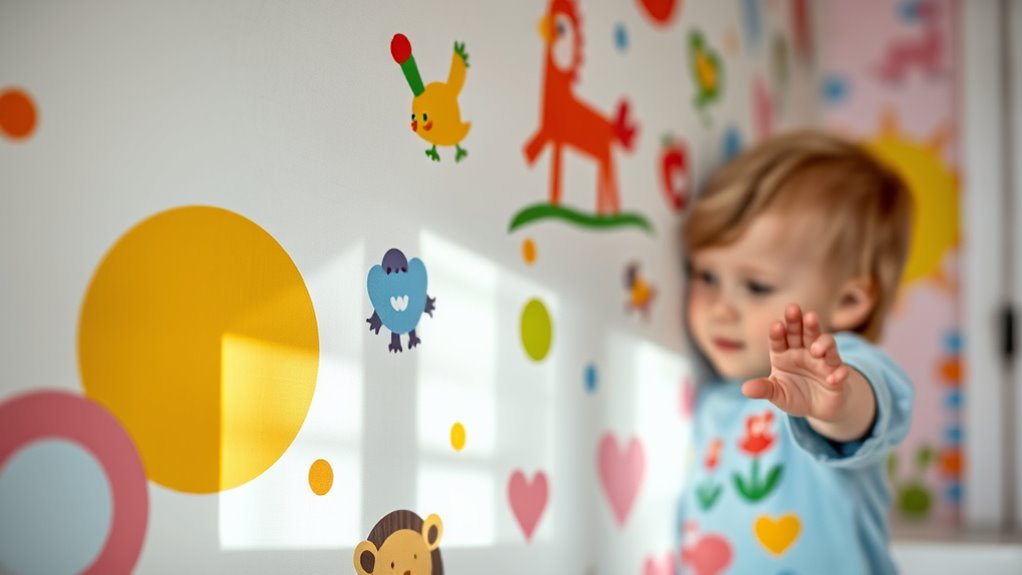
Understanding VOC emissions and indoor air quality standards is essential when choosing child-safe wallcoverings. Volatile organic compounds, or VOCs, are chemicals released into the air from many building materials, including wallcoverings. High levels of VOCs can compromise indoor air quality and pose health risks to children. To protect your family, it’s important to familiarize yourself with indoor air standards, which set limits on VOC emissions for materials used inside homes. These standards help guarantee that wallcoverings emit minimal harmful chemicals, creating a safer environment. When selecting wallcoverings, look for products that meet or exceed indoor air standards, indicating they have low VOC emissions. Doing so reduces potential health issues and promotes a healthier, safer space for your children to grow and play. Additionally, understanding air quality standards can help you make informed decisions about home materials that contribute to a healthier living environment. Being aware of emission testing processes can further ensure that the products you choose are truly low in VOCs and safe for indoor use. Moreover, compliance certifications provide added assurance that wallcoverings meet established safety criteria. Knowing how regulatory updates influence indoor air quality can help you stay current with the latest safety guidelines.
Recognizing Non-Toxic and Low-Emission Labels
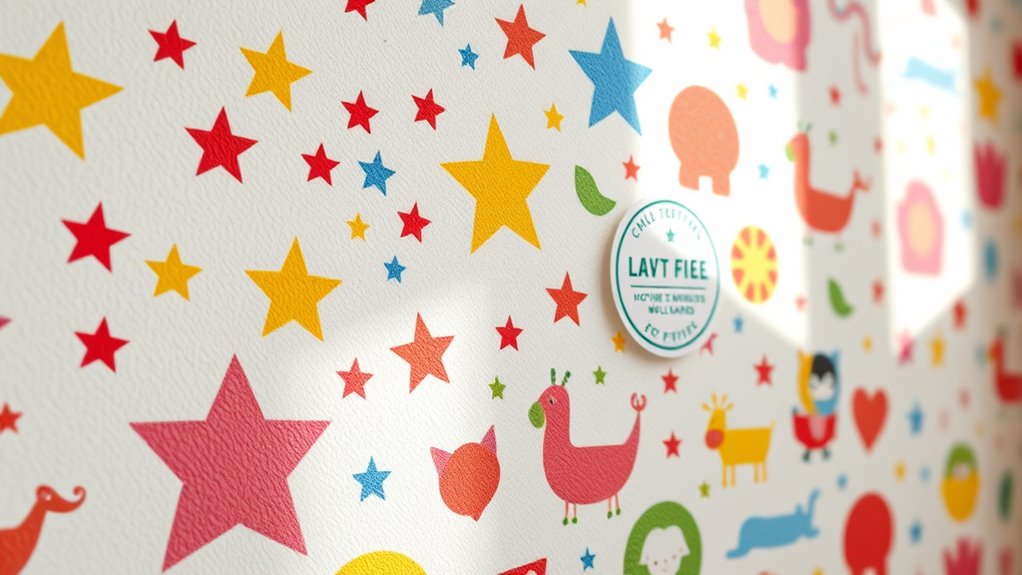
How can you quickly identify wallcoverings that are safer for your children? Look for labels indicating non-toxic or low-emission qualities, such as those certified by recognized organizations. These labels guarantee the wallcoverings meet strict standards for chemical safety, reducing harmful emissions that could affect indoor air quality. Pay attention to certifications like GREENGUARD Gold or the Blue Angel, which verify low chemical emissions. Additionally, check the product details for information about material durability, ensuring the wallcoverings are resistant to wear and tear, which prolongs their safety and appearance. Choosing products with these labels helps you prioritize chemical safety and material durability, giving you peace of mind that your child’s environment remains healthy and protected.
The Significance of Safety Certifications for Children’s Products
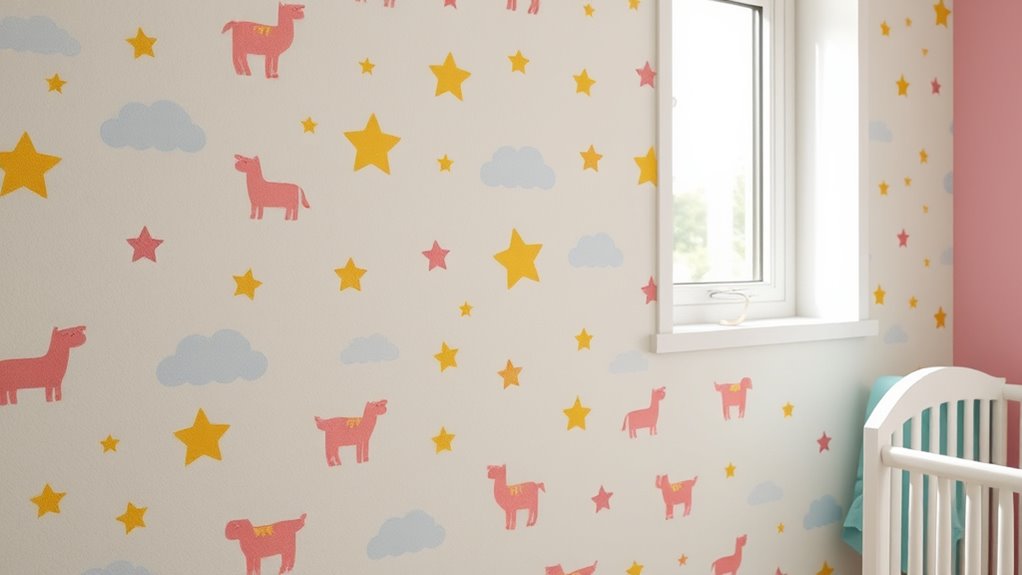
Safety certifications play a crucial role in ensuring that children’s products, including wallcoverings, meet strict health and safety standards. These certifications confirm that the products are safe from harmful chemicals, guaranteeing chemical safety for your child. They also verify that wallcoverings are durable enough to withstand everyday use without deterioration, maintaining safety over time. Recognizing these certifications helps you make informed choices and avoid products that may compromise health or durability. Additionally, certifications like Greenguard help ensure that wallcoverings contribute to healthier indoor environments. As technological innovations continue, safety standards are expected to evolve, further enhancing product safety for children. Staying informed about regulatory compliance can help parents select the safest options available.
Key Environmental and Sustainability Certifications for Wallcoverings

Choosing wallcoverings that are both safe and environmentally friendly involves considering certifications that verify their sustainability. Look for certifications like GreenGuard Gold or OEKO-TEX Standard 100, which guarantee the materials meet strict environmental and health standards. These certifications confirm that the wallcoverings use eco friendly materials, reducing harmful impacts on indoor air quality. Additionally, they verify that the finishes are chemical free, minimizing exposure to volatile organic compounds (VOCs) and other toxic substances. Incorporating sustainable manufacturing practices into your selection process further supports healthier homes and sustainable living choices. Ensuring that manufacturing processes prioritize eco friendly materials enhances the overall safety and environmental responsibility of the wallcoverings you choose. Opting for products with third-party environmental certifications offers added reassurance about their safety and sustainability credentials.
Verifying Manufacturer Transparency and Certification Authenticity
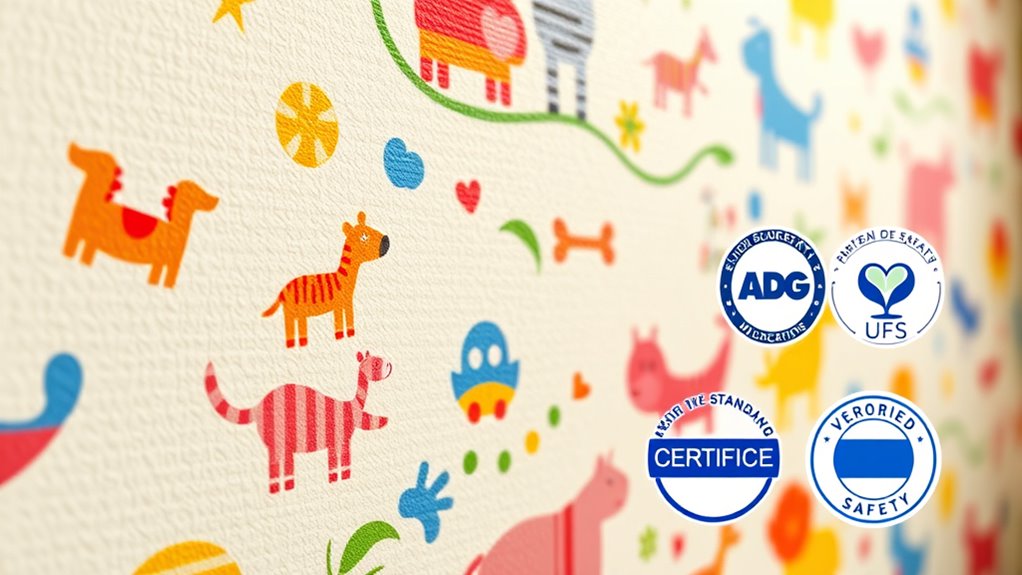
To guarantee the wallcoverings you select are truly safe and environmentally responsible, it’s vital to verify that manufacturers are transparent about their processes and certifications. Look for clear documentation and open communication that demonstrate manufacturers’ transparency. This helps ensure the certification authenticity, confirming that claims are legitimate. Ask for detailed reports or third-party verification to avoid misleading labels. Additionally, reviewing product safety standards can provide further assurance of compliance and quality. Ensuring that manufacturers disclose testing results can further demonstrate their commitment to transparency and help you make an informed choice. Furthermore, understanding regulatory compliance ensures that the products meet current legal requirements and industry benchmarks for safety. Verifying certification authenticity is essential to confirm that the safety claims are valid and recognized by reputable organizations.
Frequently Asked Questions
How Can I Identify Wallcoverings That Are Genuinely Child-Safe?
To identify genuinely child-safe wallcoverings, check the chemical labeling for non-toxic ingredients and absence of harmful chemicals. Look for safety testing results from reputable labs, ensuring the product meets safety standards for children. Always verify if the wallcoverings have certifications like UL Environment or Greenguard Gold, which confirm they’ve been tested and proven safe. By doing this, you verify the wallcoverings are suitable and safe for your child’s space.
Are There Specific Certifications for Organic or Eco-Friendly Wallcoverings?
You might notice eco labels or organic standards on the packaging as you shop, signaling that the wallcoverings meet specific eco-friendly criteria. These certifications guarantee the products are free from harmful chemicals and adhere to sustainable practices. Look for labels like Green Seal, FSC, or OEKO-TEX, which confirm the wallcoverings are organic or eco-friendly. By choosing products with these certifications, you prioritize safety and environmental responsibility in your home.
Do Certifications Vary by Country or Region?
Yes, certifications do vary by country or region because of regional differences in certification standards. When choosing child-safe wallcoverings, you need to be aware that what’s certified in one area might not meet standards elsewhere. Always check the specific certification requirements for your region to verify the wallcoverings are truly safe and compliant with local regulations. This ensures you pick products that meet the highest safety standards in your area.
How Often Should Safety Certifications Be Renewed or Updated?
You should renew safety certifications every 1-3 years, depending on the certifying body’s requirements. Keeping up with safety standard updates is essential; 85% of certifications require renewal within this timeframe. This ensures your child-safe wallcoverings meet current safety standards and comply with regulations. Regular certification renewal helps you stay informed about new safety tests and updates, providing ongoing protection and peace of mind for your family.
Can Certifications Guarantee That Wallcoverings Are Completely Free of Harmful Chemicals?
Certifications can’t guarantee wallcoverings are completely free of harmful chemicals, but they do indicate they meet strict chemical testing and certification standards. You should look for products with trusted seals and verify that manufacturers follow rigorous testing protocols. Remember, standards evolve, so staying informed about updates helps ensure safety. While certifications greatly reduce risk, it’s wise to maintain good ventilation and choose eco-friendly options whenever possible.
Conclusion
You might think all wallcoverings are safe for kids, but not all certifications guarantee non-toxic materials. By checking emissions labels and safety certifications, you guarantee your child’s environment stays healthy. Some argue that certain certifications are just marketing tricks, but research shows genuine standards truly improve indoor air quality. Don’t take chances—verify manufacturer transparency and choose wallcoverings that prioritize safety, giving you peace of mind and a healthier space for your little ones.
